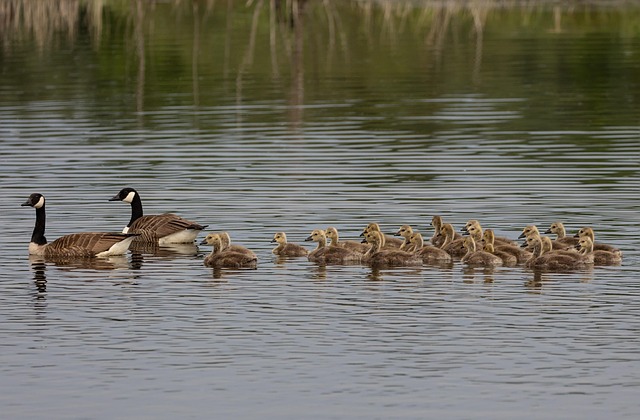Geese infestations disrupt areas with droppings, property damage, and aesthetic issues, requiring strategic, non-lethal humane goose control solutions. Visual deterrents like reflective objects and decoy predators, along with habitat modification techniques, maintain ecological balance. Restoring affected areas involves damage assessment, noise deterrents, cleaning, replanting with native species, regular monitoring, and maintenance. Preventing future infestations uses multi-faceted approaches: creating natural deterrents through habitat modification, maintaining vegetation, removing water sources, addressing nesting signs, and community collaboration.
In areas where geese infestations have taken hold, understanding and addressing the issue is crucial. This article guides you through the complex landscape of managing these bird populations humanely, offering a comprehensive look at effective, compassionate methods. We delve into the impact of geese on affected environments and provide a step-by-step restoration guide. Additionally, we explore long-term, sustainable solutions to prevent future infestations, armed with humane geese control strategies that work.
Understanding Geese Infestations and Their Impact
Geese infestations can significantly impact affected areas, leaving behind droppings that not only stain surfaces but also pose health risks by harboring diseases. Additionally, their nesting habits can lead to property damage and create unsightly scenes in public spaces, parks, and commercial landscapes. Understanding these issues is the first step towards implementing effective yet humane geese control solutions.
The challenge lies in managing the situation without causing harm to the birds, which are an essential part of many ecosystems. This requires a strategic approach that combines non-lethal deterrents, such as visual and auditory repellents, with habitat modification techniques. By employing these humane methods, it’s possible to reduce goose presence while ensuring their well-being, creating a harmonious balance between human needs and wildlife conservation.
Humane Methods for Geese Control
When dealing with goose infestations, it’s essential to explore humane methods for their control, ensuring the well-being of both wildlife and the environment. One effective yet gentle approach is using visual deterrents such as reflective objects or decoy predators like owls or falcons. These strategies disrupt the geese’s natural habits without causing harm, making them ideal for residential areas and public spaces.
Additionally, modifying the habitat can be a sustainable solution. This includes trimming vegetation to reduce nesting sites and installing fences or physical barriers around problem areas. By offering alternative feeding grounds and water sources away from sensitive locations, you can redirect geese to less problematic regions, ultimately reducing their impact on affected areas.
Restoring Affected Areas: A Step-by-Step Guide
Restoring affected areas after a goose infestation requires careful planning and implementation. Here’s a step-by-step guide to help you achieve this:
1. Assess the Damage: Begin by thoroughly inspecting the area to understand the extent of the damage caused by geese. Look for any signs of nesting, droppings, or plants that have been trampled. Documenting these findings will aid in planning the restoration process effectively.
2. Implement Humane Geese Control Solutions: Before beginning any restoration work, it’s crucial to address the ongoing goose problem. Consider using humane methods like noise deterrents, visual repellents, or habitat modification to discourage geese from returning. These solutions help maintain a peaceful environment while ensuring the well-being of both the birds and the surrounding ecosystem.
3. Clean and Remove Debris: Once the area is free from geese, start cleaning. Remove any accumulated droppings and debris using appropriate tools and protective gear. This step not only improves aesthetics but also prevents potential health hazards associated with bird waste.
4. Revitalize the Soil: Geese can leave the soil compacted or nutrient-depleted. Loosen the soil and add organic matter to enhance its fertility. This encourages new plant growth and creates a healthier environment for both plants and other wildlife.
5. Replant and Revegetate: Replace any damaged or destroyed vegetation with native species suitable for your region. Native plants are better adapted to local conditions and provide habitat for beneficial insects and wildlife, fostering biodiversity.
6. Monitor and Maintain: Regular monitoring is key to preventing future infestations. Keep an eye on the area and implement routine maintenance practices to keep the environment balanced. This includes trimming vegetation, removing food sources, and ensuring proper drainage.
Preventing Future Infestations: Long-Term Solutions
Preventing future infestations requires a multi-faceted approach that goes beyond immediate cleanup. Implementing humane geese control solutions, such as habitat modification and deterrents, can significantly reduce the likelihood of recurring issues. By altering the environment to make areas less appealing to geese, you create a natural barrier without causing harm to the birds. This includes strategies like adding plant varieties that are not attractive to geese or installing physical barriers like netting or fences around vulnerable zones.
Regular maintenance and monitoring are crucial components of long-term prevention. Keeping grass and vegetation trimmed, removing water sources where geese might breed, and promptly addressing any signs of nesting can deter them from returning. Community collaboration is also essential; by sharing resources, knowledge, and best practices, areas can collectively ensure more effective and sustained protection against future infestations.
In conclusion, addressing goose infestations requires a multi-faceted approach. By understanding the impact of these birds and adopting humane control methods, property owners can effectively manage their presence. Restoring affected areas through careful cleaning and following long-term prevention strategies ensures a balanced ecosystem. Implementing these steps not only minimizes current issues but also prevents future invasions, fostering an environmentally harmonious coexistence. When considering humane geese control solutions, it’s clear that a well-informed and compassionate approach is the key to maintaining both peace and ecological integrity.
